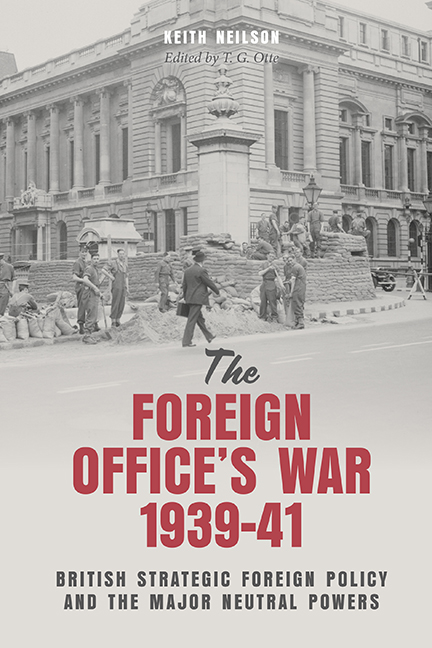Book contents
- Frontmatter
- Contents
- Preface and Acknowledgments
- List of Abbreviations
- Introduction: Keith Neilson and Modern International History
- 1 On the Eve of War: January to September 1939
- 2 The Baltic, Blockade and Soviet Russia: September 1939–June 1940
- 3 Defending the Mediterranean: Italy, Russia and the Balkans, September 1939–June 1940
- 4 Defending Britain and the Far East: The United States, Japan and Soviet Russia, September 1939–June 1940
- 5 ‘Nothing for nothing’: From the Fall of France to Operation Barbarossa: July 1940–June 1941
- Epilogue
- Appendix I Members of the American, Central, Eastern, Far Eastern, Northern and Southern Departments, 1939–41
- Appendix II Dramatis Personae
- Appendix III Keith Neilson, List of Publications
- Bibliography
- Index
4 - Defending Britain and the Far East: The United States, Japan and Soviet Russia, September 1939–June 1940
Published online by Cambridge University Press: 16 July 2022
- Frontmatter
- Contents
- Preface and Acknowledgments
- List of Abbreviations
- Introduction: Keith Neilson and Modern International History
- 1 On the Eve of War: January to September 1939
- 2 The Baltic, Blockade and Soviet Russia: September 1939–June 1940
- 3 Defending the Mediterranean: Italy, Russia and the Balkans, September 1939–June 1940
- 4 Defending Britain and the Far East: The United States, Japan and Soviet Russia, September 1939–June 1940
- 5 ‘Nothing for nothing’: From the Fall of France to Operation Barbarossa: July 1940–June 1941
- Epilogue
- Appendix I Members of the American, Central, Eastern, Far Eastern, Northern and Southern Departments, 1939–41
- Appendix II Dramatis Personae
- Appendix III Keith Neilson, List of Publications
- Bibliography
- Index
Summary
British strategic foreign policy in the Baltic and the Balkans meant dealing with Soviet Russia and Italy. The goals in both cases were similar: first, the war should be localised as much as could be achieved; second, both Moscow and Rome should be persuaded to give as little support to Berlin as possible and, if possible, weaned away from Germany. However, strategic foreign policy had other goals when dealing with Japan and the United States. This fact reflected the differing relationship between Britain and the latter two states.
Since 1931, Tokyo and London had been involved in a shadowy conflict in the Far East. While war had not been declared between them, there was little doubt that Japan was pursuing long-term goals in China that threat-ened the British position in the region. Until 1939, Japan's ambitions had been checked by indirect means: British support for China in the ongoing Sino-Japanese conflict, Japan's intermittent border clashes with Soviet Russia and the confluence of Anglo-American interests in the Far East. What Britain had to avoid was overt conflict with Japan, and, particularly, with that country operating in conjunction with Germany and Italy.
The role of the United States was unique. None of the other neutrals had such diverse and significant impacts on British strategic foreign policy as did Washington. Only the latter was never considered as an enemy; only the latter was thought to be required to ensure victory in any major European war; and only the latter was important in all of the various regions where British interests were threatened. The most obvious example of this, as we have seen, was in the Far East, but the long-term goal of British strategic foreign policy was to defeat Germany by means of blockade and economic pressure. And, to achieve this goal required Britain to have access to American supplies and finances.
The attainment of the aims of strategic foreign policy depended on circumstances. What positions would Japan and the United States adopt should war break out? Would these orientations mean that Tokyo and Washington could (or would) play the roles assigned to them by British planners? How would that other neutral, Soviet Russia, deal with matters in the Far East, particularly its relations with Japan?
- Type
- Chapter
- Information
- The Foreign Office's War, 1939-41British Strategic Foreign Policy and the Major Neutral Powers, pp. 187 - 260Publisher: Boydell & BrewerPrint publication year: 2022

